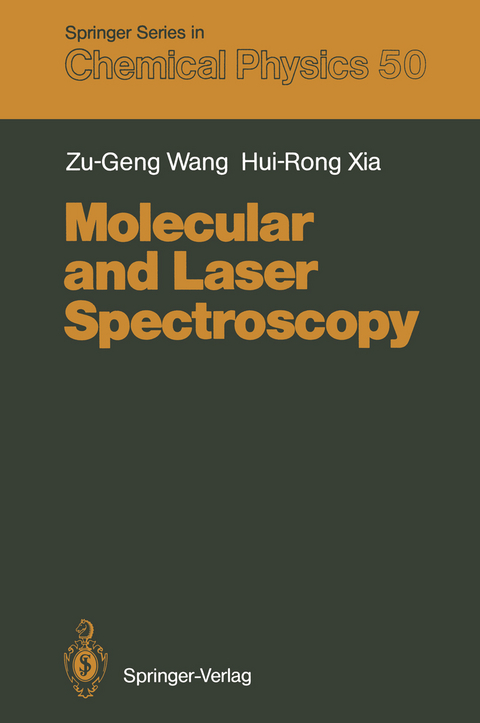
Molecular and Laser Spectroscopy
Springer Berlin (Verlag)
978-3-642-83720-3 (ISBN)
Molecular and laser spectroscopists, and research students interested in molecular, chemical, and laser phys- ics will welcome this book, which bridges the gap between molecular spectroscopy and laser spectroscopy. The theoretical concepts introduced in this text are clearly illustrated by numerous examples based on simple molecules.
1. Introduction.- 2. Molecular Energy States.- 2.1 The Molecular-Motion Equation, and the Hamiltonian Operator.- 2.2 Molecular Electronic States.- 2.3 Molecular Vibrational Levels.- 2.4 Molecular Rotational Levels.- 2.5 Molecular Vibration-Rotational Levels.- 2.6 Coupling of Molecular Rotation and Electronic Motion.- 2.7 Perturbations.- 2.8 Quadrupole Hyperfine Structure of Molecules.- 2.9 Magnetic Dipole Hyperfine Structure in Molecules.- 2.10 Isotopic Energy-Level Shifts.- 2.11 Molecular Rydberg States.- 3. Linear Molecular Spectroscopy.- 3.1 Infrared Pure-Rotational Spectra.- 3.2 Infrared Vibrational Spectra.- 3.3 Infrared Vibration-Rotational Spectra.- 3.4 Vibrational Band Systems of Diatomic Molecules.- 3.5 Rotational Spectra of Electronic Bands of Diatomic Molecules.- 3.6 Electric Quadrupole and Magnetic Dipole Hyperfine Spectra of Molecules.- 3.7 The Goals for Experimental Studies of Molecular Spectroscopy.- 3.8 Advances of Molecular Spectroscopy Through Linear Interaction of Molecules with Lasers.- 4. Spectral Characteristics of Molecular Two-Photon Transitions.- 4.1 Classification of Equal-Frequency Molecular Two-Photon Transitions.- 4.2 Excitation Probability of a Two-Photon Transition with One Near-Resonant Enhancing Level.- 4.3 Coarse Structure of Near-Resonantly Enhanced Molecular Two-Photon Absorption Spectra.- 4.4 Fine Structure of Near-Resonantly Enhanced Molecular Two-Photon Transitions.- 4.5 Line Shapes and Higher-Order Corrections for Near-Resonant Two-Photon Transitions in Three-Level Systems.- 4.6 Molecular Two-Photon Transitions Enhanced by Mixing Levels.- 4.7 Semiclassical Theory for a Two-Photon Transition in a Four-Level System.- 4.8 Coherent Effects on the Line Shape of a Near-Resonant Two-Photon Transition in a Four-Level System.- 5. MolecularNonlinear Uncoupling Spectra with Doppler-Free Spectroscopy.- 5.1 Doppler-Free Saturation Spectroscopy and Its Development.- 5.2 Doppler-Free Polarization Spectroscopy and Its Development.- 5.3 Doppler-Free Two-Photon Spectroscopy and Its Development.- 5.4 Superhigh-Resolution Spectroscopy with Separated Fields.- 5.5 Applications of Nonlinear High-Resolution Laser Spectroscopy to Studies of Molecular Spectra.- 6. Molecular Nonlinear Coupling Spectral Effects.- 6.1 Background.- 6.2 Nonlinear Coupled Interaction in Three-Level Systems.- 6.3 Nonlinear Coupled Interaction in Four-Level Systems.- 6.4 Stimulated Diffuse Band Radiation via Various Excitation Processes.- 6.5 Stimulated and Coherent Radiation by Hybrid Excitation in Molecule-Atom Ensembles.- 6.6 Optically Pumped Stimulated Radiation Based on Molecular Electronic Transitions.- 6.7 Lasers Based on Molecular Photodissociation.- 6.8 Optically Pumped Far-Infrared Lasers Based on Pure Rotational Molecular Transitions.- 6.9 Optically Pumped Mid-Infrared Laser Based on Molecular Vibration-Rotational Transitions.- 6.10 Applications of Coherent Transient Spectroscopy in the Measurement of Molecular Parameters.- 7. Simplification and Identification of Molecular Spectra.- 7.1 Laser-Induced Fluorescence.- 7.2 Population Labelling.- 7.3 Polarization Labelling.- 7.4 Two-Step Polarization Labelling.- 7.5 Modulated Polarization Two-Photon Spectroscopy.- 7.6 Molecular Energy Level Information Provided by Selective Simplified Molecular Spectra.- 7.7 Comprehensive Identification of Equal-Frequency Molecular Two-Photon Transitions.- References.
| Erscheint lt. Verlag | 8.12.2011 |
|---|---|
| Reihe/Serie | Springer Series in Chemical Physics |
| Mitarbeit |
Stellvertretende Herausgeber: Arthur L. Schawlow |
| Zusatzinfo | XI, 281 p. |
| Verlagsort | Berlin |
| Sprache | englisch |
| Maße | 155 x 235 mm |
| Gewicht | 451 g |
| Themenwelt | Naturwissenschaften ► Physik / Astronomie ► Atom- / Kern- / Molekularphysik |
| Schlagworte | Laser • lasers • Laser Spectroscopy • Laserspektroskopie • Molecular Spectra • Molecule • Molekülphysik • Spectra • spectroscopy |
| ISBN-10 | 3-642-83720-4 / 3642837204 |
| ISBN-13 | 978-3-642-83720-3 / 9783642837203 |
| Zustand | Neuware |
| Haben Sie eine Frage zum Produkt? |
aus dem Bereich


